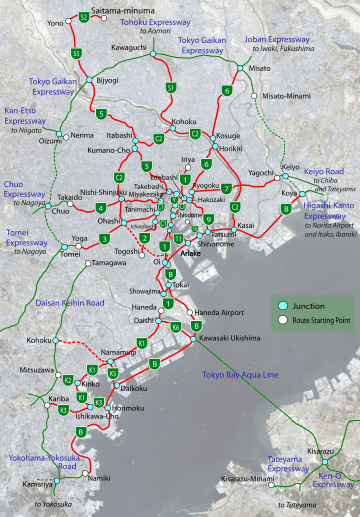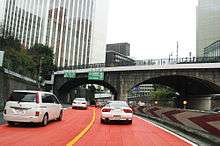Shuto Expressway
 | |
| Public | |
| Industry | Transportation |
| Founded | 2005 |
| Headquarters | Tokyo, Japan |
Area served | Tokyo, Kanagawa Prefecture, Chiba, Saitama |
Key people | Katsumi Sasaki, (CEO) |
| Products | Maintenance |
| Revenue |
|
Number of employees | 2609 (2008) |
| Subsidiaries | Metropolitan Expressway Service Co, Ltd. |
| Website | www.shutoko.jp |

Shuto Expressway (首都高速道路 Shuto Kōsoku Dōro, lit. Metropolitan Expressway) is a network of toll expressways in the Greater Tokyo Area of Japan. It is operated and maintained by the Metropolitan Expressway Co., Ltd. (首都高速道路株式会社 Shuto Kōsoku Dōro Kabushiki-gaisha).
Most routes are grade-separated (elevated roads or tunnels) and central routes have many sharp curves and multi-lane merges which require caution to drive safely. The speed limit is 60 km/h on most routes, but 80 km/h on the Bayshore Route, and 50 km/h on the Inner Circular Route.
All trips on the expressway require a toll be paid. As of 2014, the cash toll for a standard-size car is ¥930 regardless of distance travelled. Vehicles using the ETC toll-collection system pay a distance-based toll ranging from ¥510 to ¥930 for ordinary vehicles (see toll price) – in some cases substantially less than the previous fixed-rate toll. Lower cash rates exist for certain radial routes (where there are only a few kilometers of expressway remaining) and ETC users have various time-of-day discounts. For large vehicles, the toll is doubled.
Routes
There are 24 routes currently in operation:
Circular (loop) routes
- C1 Inner Circular Route
- C2 Central Circular Route — loop incorporating the Yamate Tunnel.
- Y Yaesu Route — via Tokyo Expressway




Bayshore route
- B Bayshore Route (Higashi-Kanto-Expressway – ) Chidori-cho – Sachiura / Namiki ( – Yokohama–Yokosuka Expressway)
Radial routes
- No. 1 Ueno Route Edobashi JCT – Iriya
- No. 1 Haneda Route Hamazakibashi JCT – Haneda ( – Route K1)
- No. 2 Meguro Route Ichinohashi JCT – Togoshi / Ebara
- No. 3 Shibuya Route Tanimachi JCT – Yoga ( – the Tomei Expressway)
- No. 4 Shinjuku Route Miyakezaka JCT – Takaido ( – the Chuo Expressway)
- No. 5 Ikebukuro Route Takebashi JCT – Bijogi JCT ( – Route S5)
- No. 6 Mukojima Route Edobashi JCT – Horikiri JCT ( – Route C2)
- No. 6 Misato Route Kosuge JCT – Misato JCT ( – Tokyo Gaikan Expressway)
- No. 7 Komatsugawa Route Ryogoku JCT – Ichinoe ( – Keiyo Road)
- No. 9 Fukagawa Route Hakozaki JCT – Tatsumi JCT ( – Bayshore Route)
- No. 10 Harumi Route Ariake JCT – Toyosu
- No. 11 Daiba Route Shibaura JCT – Ariake JCT (Tokyo Rainbow Bridge)
- No. 12 Daiba Route Shibaura JCT – Ariake JCT (Tokyo Rainbow Bridge)
Kanagawa routes
- K1 Yokohane Route (Route 1 – ) Haneda - Ishikawa-cho JCT ( – Route K3)
- K2 Mitsusawa Route Kinko JCT – Mitsuzawa ( – Yokohama Shindo Road and Daisan Keihin Road)
- K3 Kariba Route Honmoku JCT – Kariba ( – Yokohama Shindo Road and Yokohama-Yokosuka Expressway)
- K5 Daikoku Route (Route K1 – ) Namamugi JCT - Daikoku JCT ( – Bayshore Route)
- K6 Kawasaki Route Tonomachi – Kawasaki-Ukishima JCT ( – Bayshore Route and Tokyo Bay Aqualine)
Saitama routes
- S1 Kawaguchi Route (Route C2 – ) Kohoku JCT – Kawaguchi JCT ( – Tokyo Gaikan Expressway)
- S2 Saitama Shintoshin Route (Route S5) Yono – SaitamaMinuma
- S5 Omiya Route (Route 5 – ) Bijogi JCT – Yono ( – Route S2)
History
The Metropolitan Expressway was first built between Kyobashi Exit in Chūō, Tokyo and Shibaura Exit in Minato, Tokyo in 1962 for the purpose of increasing traffic flow efficiency in the Tokyo Metropolitan Area, thus optimizing and improving the functionality of the traffic system. Since then, 280 kilometres of highway network has been built in the Tokyo metropolitan area; 30 kilometres more of highway are either constructed or planned, making the Metropolitan Expressway a vast network of urban expressways in the Tokyo region.
Motorcycles with passengers
Like all other expressways in Japan, two-wheeled motorcycles with passengers were banned for many years. Even though a legal amendment on 1 April 2005 generally allows a person aged at least 20 with a motorcycle driver license for at least 3 years to carry a passenger on a two-wheel motorcycle on an expressway, some segments of the Shuto still prohibit passengers. These segments include the important C1 route and adjoining central Tokyo routes. With the opening of the Yamate Tunnel Ohashi junction in 2010, motorcycles with passengers are finally able to pass through the Shuto Expressway from the Tomei to other expressways using the C2 route, although this can be a much longer drive in some cases. See this map for details.
Parking areas
There are 21 parking areas scattered throughout the Shuto Expressway system. In general these are much smaller than the service areas available every 30 km or so on inter-city expressways. In some cases they are no more than toilets, a few vending machines, and a handful of parking spaces. None have fuel – drivers must exit the system (and pay the toll again on re-entry) to use a service station.
Street racing
Like all other expressways in Japan including the Tomei Expressway, the Shuto line has become a common street racing road. One of the lines, Bayshore Route (or known as the Wangan by hashiriya), received worldwide notoriety during the 1990s as the home course for the MidNight Club, one of the most notorious street racing clubs, who were known for their 300 km/h, sometimes 320 km/h exploits.
Due to this infamy, the Wangan is the setting for several entertainment properties, such as the manga and arcade game Wangan Midnight, video games Shutokou Battle and Gran Turismo 5 and Gran Turismo 6 (without traffic) and the movie series Shuto Kousoku Trial. Numerous car enthusiast magazines and DVDs, like Best Motoring, also highlight races and activities on the Wangan.[1][2][3]
See also
References
External links
| Wikimedia Commons has media related to Metropolitan Expressway (Tokyo). |
Coordinates: 35°39′39″N 139°44′15″E / 35.660814°N 139.737560°E
